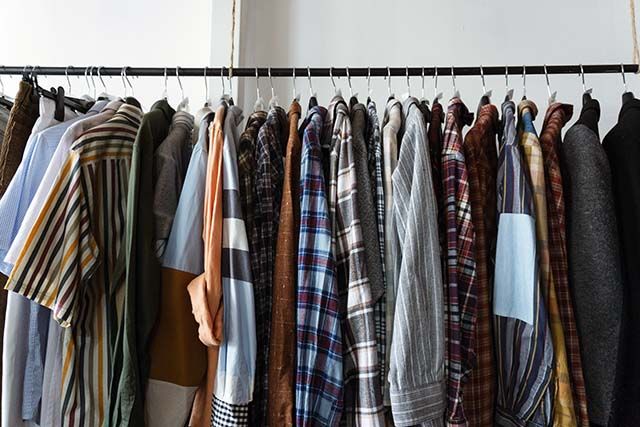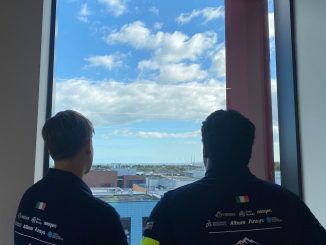
[dropcap][/dropcap]Lockdown boredom may have caused many of us to see delivery drivers at our front doors far more than our friends and family. However, this year has given many a chance to reflect on the impact our purchases have on the world we live in.
Gone are the days of wearing an outfit once and discarding it once a successful Instagram has been posted. Finding unique vintage bits that you will love forever is the fashion trend that never become unfashionable. Shedding light on the forgotten items in your wardrobe and finally making use of the sewing kit disguised as a tin of biscuits, is the best way to turn heads for all the right reasons.
Sarah Mc Guinness, a journalism student in DCU feels that her generation grew up surrounded by fast fashion. Accidentally matching tops was an all too common occurrence and information about where these tops came from was scarce.
“There was little conversation about the environmental and ethical injustices of fast fashion because people were so blinded by the novelty. Our generation grew up with the likes of Penney’s and New Look, and later Boohoo and Pretty Little Thing at our fingertips” explains the 21 year- old. New voices emerged in McGuiness’ late teens that changed her perception of what actually makes an outfit great. “What was new and rapidly growing in our teen years were concerns about climate change and critical dialogues surrounding the practices of sweat shops, so rather than fast fashion capturing our attention, Greta Thunberg and Extinction Rebellion did instead.”
It wasn’t until McGuiness went to college that she felt she could experiment with her wardrobe. “I started becoming more conscious of the environmental impact of my shopping habits in sixth year, but it wasn’t until I got my own job upon starting college and could afford to start buying my own clothes did I really get into Depop! Once I had my own money I was able to explore other more sustainable avenues and since then I mostly shop second hand.”
Often people may feel put off by sustainable fashion and long for the sales that seem too good to be true on online sites boosted by former reality show stars. Taking a fresh look at the clothes you already own instead of clicking ‘add to cart’ is a great way to make a small, positive change.
Eibhlín Byrne, 19 explains that sustainable fashioning does not have to break the bank. The Carlow native has always enjoyed crafting and creating her own clothing. Byrne’s love of fashion was apparent from a young age. “I became interested in it when I was eleven when my Mam got me this Top Model book where I could draw my own little designs and I became obsessed. I actually was sewing since I was 8 years old and I would do embroidery and knitting”
When Byrne was a little older she turned her hand to crochet, creating her own tops and bags. Making your own clothes is in the style at the moment with custom fleeces and Harry Styles cardigans selling out within minutes. This was not always the case.
“When I was in primary school I started (knitting) with a friend in a class and people liked to call us a granny club”, she laughs. We have all tried to pick up new skills when our iced coffees weren’t up to scratch. Young people around the country now aspiring to be members of the ‘granny club’, fixing old favourites that have been collecting dust or trying our hand that stitching a face mask.
Byrne only recently learned about the impact of fast fashion and the importance of her thread and needle. “I wasn’t actually aware at all of the impact it had until I say I was 16. And last year was when I began doing some research on it. I made the decision to try cut down on fast fashion and I was shopping more frequently in charity shops.”
She advises second hand shop newbies to take their time to browse and explore. “I think it’s so much fun. You definitely develop a unique sense of style and you can find such amazing gems. You can find so much and not spend much money. My absolute favourite clothes are second hand.”
Gary Kelly of @retrospectclothing_ explains how his passion became a business when the country shut down. “It was basically just a little project for myself to keep busy and it just grew from there.” He explains that finding unique and individual pieces while staying environmentally conscious is more important to people than ever before. “You just don’t get them from mass producing clothing companies. Whereas, it is much less likely to meet someone wearing the same outfit as you if you’re wearing vintage!”
Kelly suggests choosing some choice pieces you will feel great in rather than bulk buying things that will clutter your bedroom. “Buying a lot less is important if you buy clothing you love and know you will appreciate for a long time instead of buying for the sake of it because it’s on sale is a great way to be sustainable as well.”
Amy Donohoe is a climate ambassador and an expert in all things environmentally friendly. She suggests checking out sewing YouTube tutorials to upcycle the pieces that already make you feel great and trying not to buy into this month’s must have.
“It’s not even just clothes that are more disposable. Everything is a trend these days.”
That scarf in the back of your wardrobe can become an Instagrammable crop top. Why not throw those jeans that never really fitted properly onto Depop for somebody else to enjoy wearing?
Fifty-two micro seasons of fashion year come and go each year. Thankfully, finding and embracing your own sustainable style stand the test of time.
https://www.retrospectclothing.ie/
Róisín Cullen
Image Credit: AndreeapopOnUnsplashRGB



